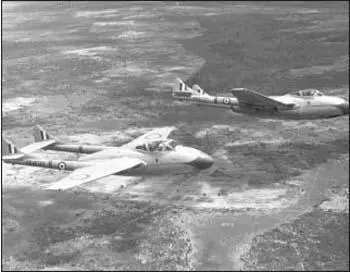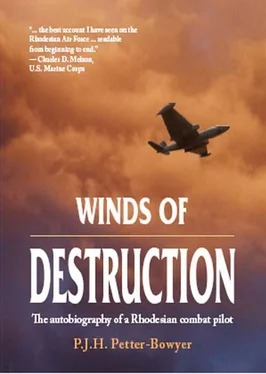Peter Petter-Bowyer - Winds of Destruction
Здесь есть возможность читать онлайн «Peter Petter-Bowyer - Winds of Destruction» весь текст электронной книги совершенно бесплатно (целиком полную версию без сокращений). В некоторых случаях можно слушать аудио, скачать через торрент в формате fb2 и присутствует краткое содержание. Город: Solihull, Pinetown, Год выпуска: 2012, ISBN: 2012, Издательство: Helion & Company, 30° South Publishers, Жанр: Биографии и Мемуары, на английском языке. Описание произведения, (предисловие) а так же отзывы посетителей доступны на портале библиотеки ЛибКат.
- Название:Winds of Destruction
- Автор:
- Издательство:Helion & Company, 30° South Publishers
- Жанр:
- Год:2012
- Город:Solihull, Pinetown
- ISBN:9781908916754
- Рейтинг книги:5 / 5. Голосов: 1
-
Избранное:Добавить в избранное
- Отзывы:
-
Ваша оценка:
- 100
- 1
- 2
- 3
- 4
- 5
Winds of Destruction: краткое содержание, описание и аннотация
Предлагаем к чтению аннотацию, описание, краткое содержание или предисловие (зависит от того, что написал сам автор книги «Winds of Destruction»). Если вы не нашли необходимую информацию о книге — напишите в комментариях, мы постараемся отыскать её.
Winds of Destruction — читать онлайн бесплатно полную книгу (весь текст) целиком
Ниже представлен текст книги, разбитый по страницам. Система сохранения места последней прочитанной страницы, позволяет с удобством читать онлайн бесплатно книгу «Winds of Destruction», без необходимости каждый раз заново искать на чём Вы остановились. Поставьте закладку, и сможете в любой момент перейти на страницу, на которой закончили чтение.
Интервал:
Закладка:
We had been practising our cockpit drills on the side-by-side Vampire T11 trainer for some time. So we were well and truly ready when allocated to our instructors the very next day. Mine was Flight Lieutenant John Mussell whom I had not seen before his arrival from Aden.
Learning to fly a jet was totally different to what I expected. Flight Lieutenant Mussell was easygoing and talkative, the nose wheel design made taxiing so much easier than the propeller-driven ‘tail-dragger’ Provost, the engine sounded quiet inside the closed cockpit and take-off was a dream—though controls were noticeably heavy.
This first flight in a jet was on a cloudy day with intermittent bursts of sunlight. I was amazed by the speed once airborne, with stratus clouds zipping fast overhead. Once through, the fluffy white structures fell away rapidly as the Vampire made its seemingly effortless climb. Flight seemed so quiet and smooth with only a gentle background hissing from the high-speed airflow and a muffled rumbling from the Goblin jet engine embedded in the airframe behind us.
On this first sortie I not only experienced stalling, spinning and steep turning but was given an introduction to jet aerobatics. All seemed easier than flying a Provost, though two situations were trying. Firstly, steep turning and aerobatics brought about much higher ‘G’ loadings than I had known before. The Provost’s 4.5 Gs was now replaced by up to 6 Gs so I found turning my head very difficult and raising an arm required considerable effort.

The second difficulty concerned jet engine handling, which did not compare with a Provost’s instant response to throttle movement. The Vampire’s Goblin engine had to be handled very gently in the low rpm regions because rapid application of throttle would flood the engine and cause it to flame out. Once engine speed reached 9,000 rpm, the throttle could be advanced quite rapidly.
Back in the Thornhill circuit things changed a great deal. I simply could not get through all the pre-landing checks on the downwind leg before it was time to commence the continuous descending turn onto the runway. Going around again also required speeds of action that had me sweating. Within a few sorties I was coping well and could not understand why I had been so hard pressed in the first place. My whole course agreed that flying the Vampire T11 was not only great fun it was much easier to handle than the propeller-driven, ‘tail-dragger’ Provost.
Flying at high altitude was not only wonderful in itself; it induced a sense of awe from the sheer vastness of the air mass and the beauty surrounding me. By day the colour of the sky varied from the stark dark blue above to the light smoky blue of the far-off horizon. The sheer whiteness and gentle contours of clouds contrasted greatly with the blue above and the motley browns and greens of hills, trees, fields, rivers, dams and open veld far below.
On dark nights it seemed as if the stars had multiplied both in number and brightness and they appeared so close that one felt it possible to reach out and touch them. Although aerobatics were disallowed at night, I enjoyed diving for speed then pitching up to about sixty degrees before rolling the aircraft inverted. Once upside down, I allowed the aircraft to pitch gently at zero G as I gazed at the stars imagining myself to be flying in space with the stars spread out below me. The majesty of this was greatly enhanced by the wonderful sensations that accompany weightlessness.
My greatest joy came on those rare occasions flying in full moonlight between towering cumulonimbus clouds whose huge structures were illuminated in dazzling lightning displays of immeasurable beauty. In such surroundings one feels very small, but cosy and safe within the compact cockpit, while sensing God’s immeasurable power all around.
The Royal Rhodesian Air Force possessed more Vampire FB9 single-seater aircraft than Vampire T11s. ‘FB’ denotes fighter-bomber and ‘T’ trainer. Whereas a Vampire T11 was fitted with two Martin Baker ejector seats, each incorporating parachute and emergency pack, the FB9 lacked this comforting luxury. Its single seat, just like the Provost, was known as a bucket seat.

A pilot had to strap on his parachute before climbing into the FB9 cockpit and, on entry, the parachute upon which the pilot sat fitted into the ‘bucket’ of the seat. When flying long-range sorties, particularly over water, a survival pack was included between the pilot’s buttocks and his parachute. The only similarity between this arrangement and the permanent survival pack, upon which a pilot sat in an ejector seat, was the immense discomfort of sitting on a hard, lumpy pack. Any flight of more than an hour usually ended with a pilot emerging from his cockpit rubbing a sore, numb bum.
Because of the Vampire’s twin-boomed tail arrangement, with the tail plane set between the booms, a major collision hazard existed for any pilot having to abandon his aircraft in flight. The Vampire FB9 had such a bad reputation for RAF pilots being killed when abandoning stricken aircraft that the fitment of ejector seats had been considered. However, cost for modification was so high that the RAF withdrew Vampire FB9s from service and replaced them with up-rated single-seater Venom fighter-bombers fitted with ejector seats. (These were the aircraft I had seen over Umtali that excited me so much, causing me to join the Air Force.) Due to a lack of Federal defence funds, our Air Force took on refurbished FB9s from Britain at very low cost, fully accepting the risks involved in operating them.
Not only were FB9s without ejector seats, they had a very bad reputation for their habit of stabilising in a spin. In this situation, recovery to normal flight was impossible and the aircraft simply kept spinning until it hit the ground. In consequence, intentional spinning of the FB9 was disallowed. The T11, however, was cleared for spinning when an instructor was present. Yet, even though the twin fins of T11s had an improved profile and larger surface area to make spin-recovery more certain, there were some occasions when this aircraft would not respond to pilot recovery actions.
Such was the case on 8 January 1957 when Rob Gaunt of No 9 SSU was on an instructional flight with Flight Lieutenant Brian Horney. They were forced to jettison the canopy and eject when their T11 failed to respond to spin recovery within the prescribed eight revolutions. The strange thing was that, once they had ejected, the aircraft recovered into wings level flight and continued downward in a powerless glide to its destruction.
All members of my course were pretty apprehensive about flying the FB9, having learned how naughty the aircraft could be. At the same time we had reason to look forward to flying this type because we had been told it was much like flying a Spitfire without the visual limitations given by a long nose and forward-set wings. Nor was an FB9 pilot troubled by the gyroscopic swing and high torque problems that arose from the Spitfire’s huge propeller and immensely powerful, high-response piston engine.
I was the first of my course to fly solo in the T11 having flown a solo test with Flight Lieutenant Colin Graves, the Squadron Commander. This was not a once-around-the-circuit affair, but a full hour including aerobatics. When I taxiied into dispersals a reporter, who had come to cover the first ever jet solo at Thornhill, photographed me. Dave Thorne had done such a good job with the reporter that I was saved an interview and an hour later Dave himself made his first solo flight. Following my first solo, I flew a further three solos and a dual flight before moving to the FB9.
Читать дальшеИнтервал:
Закладка:
Похожие книги на «Winds of Destruction»
Представляем Вашему вниманию похожие книги на «Winds of Destruction» списком для выбора. Мы отобрали схожую по названию и смыслу литературу в надежде предоставить читателям больше вариантов отыскать новые, интересные, ещё непрочитанные произведения.
Обсуждение, отзывы о книге «Winds of Destruction» и просто собственные мнения читателей. Оставьте ваши комментарии, напишите, что Вы думаете о произведении, его смысле или главных героях. Укажите что конкретно понравилось, а что нет, и почему Вы так считаете.












